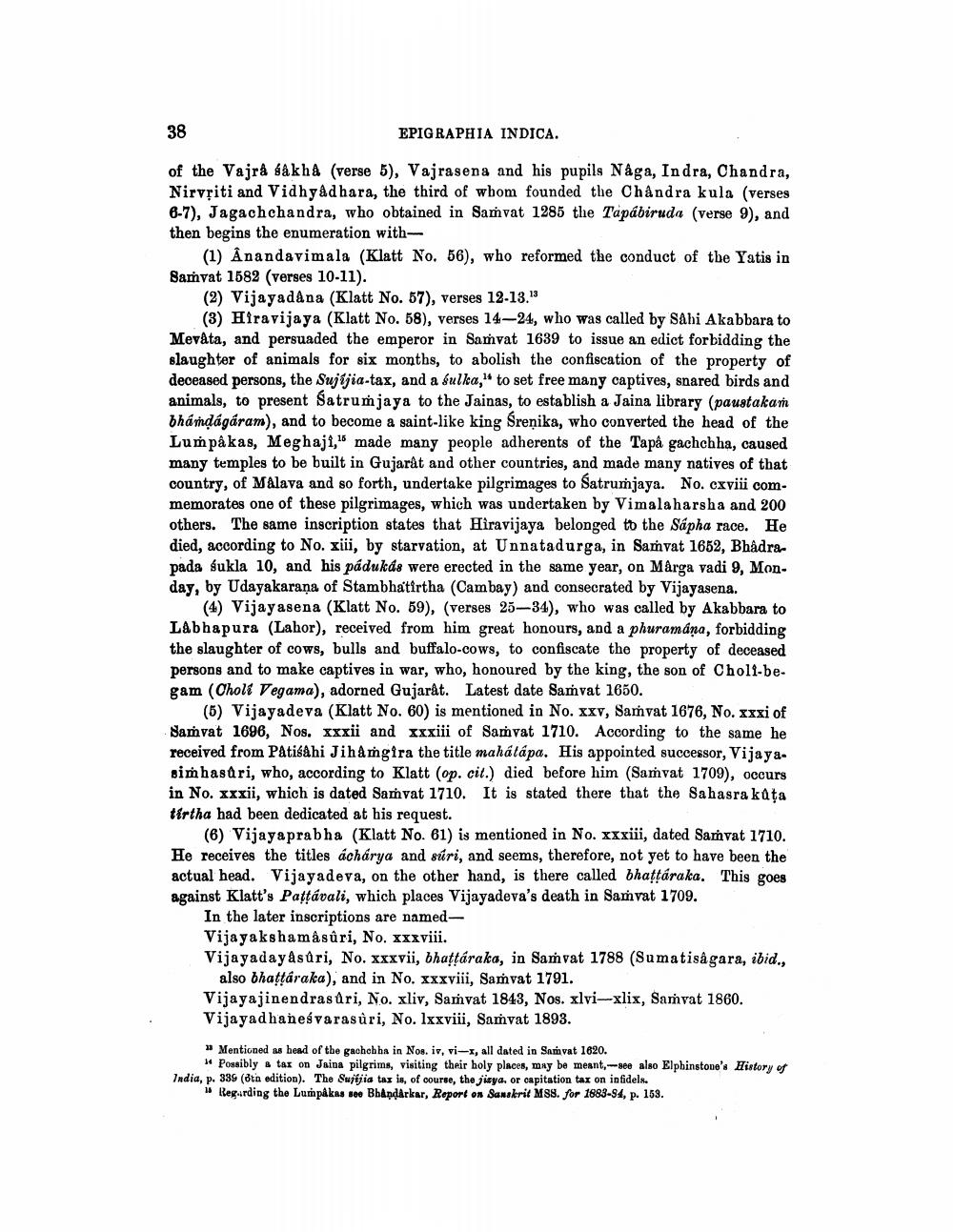________________
EPIGRAPHIA INDICA.
of the Vajra bakha (verse 5), Vajrasena and his pupils Naga, Indra, Chandra, Nirvșiti and Vidhyadhara, the third of whom founded the Chåndra kula (verses 6-7), Jagachchandra, who obtained in Sarvat 1285 the Tapabiruda (verse 9), and then begins the enumeration with
(1) Anandavimala (Klatt No. 56), who reformed the conduct of the Yatis in Samvat 1582 (verses 10-11).
(2) Vijayadana (Klatt No. 57), verses 12-13.3
(3) Hiravijaya (Klatt No. 58), verses 14-24, who was called by Sahi Akabbara to Mevata, and persuaded the emperor in Samvat 1639 to issue an edict forbidding the slaughter of animals for six months, to abolish the confiscation of the property of deceased persons, the Sujijia-tax, and a bulka," to set free many captives, snared birds and animals, to present Satruńjaya to the Jainas, to establish a Jaina library (paustakam bhárdágáram), and to become a saint-like king Sreņika, who converted the head of the Lumpákas, Meghajî,18 made many people adherents of the Tapå gachchha, caused many temples to be built in Gujarat and other countries, and made many natives of that country, of Malava and so forth, undertake pilgrimages to Satrumjaya. No. cxviii commemorates one of these pilgrimages, which was undertaken by Vimalaharsha and 200 others. The same inscription states that Hiravijaya belonged to the Sápha race. He died, according to No. xiii, by starvation, at Unnatadurga, in Saṁvat 1652, Bhadrapada sukla 10, and his pádukds were erected in the same year, on Márga vadi 9, Monday, by Udayakarana of Stambhatirtha (Cambay) and consecrated by Vijayasena.
(4) Vijayasena (Klatt No. 59), (verses 25—34), who was called by Akabbara to Labhapura (Lahor), received from him great honours, and a phuramána, forbidding the slaughter of cows, bulls and buffalo-cows, to confiscate the property of deceased persons and to make captives in war, who, honoured by the king, the son of Choli-begam (Choli Vegama), adorned Gujarat. Latest date Samvat 1650.
(6) Vijayadeva (Klatt No. 60) is mentioned in No. xxv, Samvat 1676, No. xxxi of Samvat 1696, Nos. xxxii and xxxiii of Samvat 1710. According to the same he received from Patisahi Jihamgira the title mahátápa. His appointed successor, Vijaya. simhasari, who, according to Klatt (op. cit.) died before him (Samvat 1709), occurs in No. xxxii, which is dated Samvat 1710. It is stated there that the Sahasra kata tirtha had been dedicated at his request.
(6) Vijayaprabha (Klatt No. 61) is mentioned in No. xxxiii, dated Samvat 1710. He receives the titles acharya and súri, and seems, therefore, not yet to have been the actual head. Vijayadeva, on the other hand, is there called bhattáraka. This goes against Klatt's Pattávali, which places Vijayadeva's death in Samvat 1709.
In the later inscriptions are namedVijayakshama sûri, No. xxxviii. Vijayadayasuri, No. xxxvii, bhattáraka, in Samvat 1788 (Sumatisagara, ibid.,
also bhattáraka), and in No. xxxviii, Samvat 1791. Vijayajinendrasuri, No. xliv, Samvat 1843, Nos. xlvi-xlix, Samvat 1860. Vijayad hanesvaras ùri, No. lxxviii, Samvat 1893.
* Mentioned as head of the gachchha in Nos. iv, vi-, all dated in Samvat 1620.
Possibly tax on Jaina pilgrims, visiting their holy places, may be meant-se also Elphinstone's History of India, p. 389 (8th edition). The Switia tas is, of course, the jiaya, or capitation tax on infidels.
15 Regarding the LumpAkas 1oo Bhandarkar, Report on Sanskrit M88. for 1883-84, p. 163.




